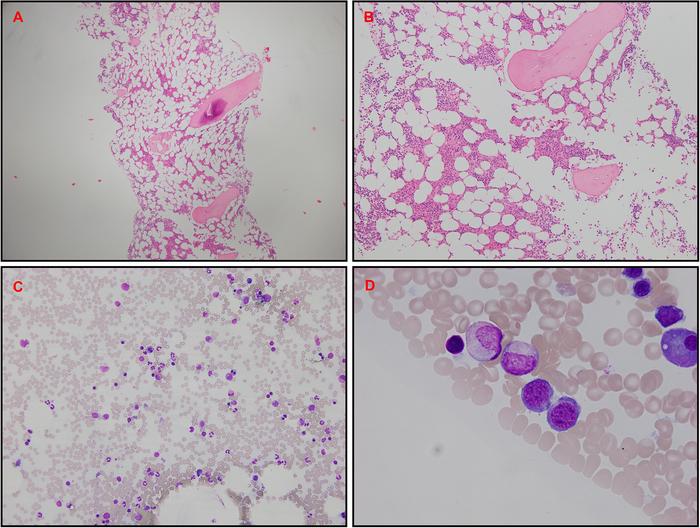Is genetics the cause of mystery osteoporosis?

Bone marrow biopsy. (A and B) Hematoxylin and eosin trephine stain demonstrating mild to moderate hypocellular marrow (20%–30%) with moderately reduced erythropoiesis. (C and D) Aspirate demonstrating mild dyserythropoiesis with normal granulocytic and megakaryocytic lineages.
Credit: Hudson Institute of Medical Research
A recently discovered genetic mutation could be the cause of some severe and baffling cases of osteoporosis – including in young people.
The condition called idiopathic osteoporosis (IOP) occurs in younger adults and often involves bone fractures, even in patients with no history of physical trauma.
Head of Hudson Institute’s Metabolic Bone Research Group, Associate Professor Frances Milat, says the condition is often challenging to diagnose and treat due to factors including a poor understanding of the underlying cause, a lack of management guidelines, and limited research in this area.
“IOP has been associated with abnormal bone structure. It is thought that IOP patients may have a yet undiscovered genetic mutation that is responsible for their severe osteoporosis and multiple fractures,” said A/Prof Milat, who is also Deputy Director of Endocrinology at Monash Health.
Genetic variant behind unexplained osteoporosis
“Our team of clinicians and scientists identified a novel RUNX1 genetic variant in a young male patient that may have caused changes in bone structure and severe osteoporosis. This patient had suffered from multiple fractures with little or no trauma.
“This genetic mutation may be the cause of some cases of unexplained severe osteoporosis in young adults,” she said.
Finding genetic link opens care and therapy options
The research was published in the journal JBMR Plus. First author Dr Tomasz Block, an Advanced Trainee in Endocrinology at Monash Health, said the successful identification of underlying genetic causes of osteoporosis can lead to appropriate preventive care for patients, including surveillance and/or directed treatment to reduce the risk of a future fracture.
“This study gives insight into a potential genetic cause for unexplained severe osteoporosis and potential targeted therapy,” he said.
“In the case described, bone formation is potentially impaired by this mutation and therefore, the optimal treatment for this patient would be medications that stimulate new bone to form.”
What is idiopathic osteoporosis?
- Idiopathic osteoporosis (IOP) can adversely affect bone formation and bone resorption, often leading to abnormal bone structure and multiple atraumatic bone fractures.
- The mean age at diagnosis is 35 years and a family history of osteoporosis is common.
- The condition affects both males and females.
- Further research is needed to identify additional genetic and non-genetic causes of IOP.
Symptoms of idiopathic osteoporosis
Osteoporosis is called a ‘silent’ disease” because there are typically no symptoms until a bone is broken. Patients can present with:
- Back pain
- Loss of height
- Fractures or breaks, especially in the spine, hip, or wrist
- Stooped posture
- Difficulty standing or walking.
Treatments
While there is no known cure for idiopathic osteoporosis, there are several treatment options available to help manage the condition and prevent further bone loss.
Making certain lifestyle changes can also help manage idiopathic osteoporosis. These include
- Regular exercise, particularly weight-bearing exercises
- A diet rich in calcium and vitamin D
- Quitting smoking
- Limiting alcohol consumption
Collaborators | Alfred Health, Monash Health
Journal information | Block TJ, Shore-Lorenti C, Zebaze R, Kerr PG, Kalff A, Perkins AC, Ebeling PR, Milat F. (2023) A Novel RUNX1 Genetic Variant Identified in a Young Male with Severe Osteoporosis. JBMR Plus. DOI: https://doi.org/10.1002/jbm4.10791
Journal: JBMR Plus
DOI: 10.1002/jbm4.10791
Method of Research: Case study
Subject of Research: People
Article Title: A Novel RUNX1 Genetic Variant Identified in a Young Male with Severe Osteoporosis
Article Publication Date: 29-Jul-2023
Media Contact
Rob Clancy
Hudson Institute of Medical Research
communications@hudson.org.au
Cell: 0408579313
All latest news from the category: Health and Medicine
This subject area encompasses research and studies in the field of human medicine.
Among the wide-ranging list of topics covered here are anesthesiology, anatomy, surgery, human genetics, hygiene and environmental medicine, internal medicine, neurology, pharmacology, physiology, urology and dental medicine.
Newest articles
Faster, more energy-efficient way to manufacture an industrially important chemical
Zirconium combined with silicon nitride enhances the conversion of propane — present in natural gas — needed to create in-demand plastic, polypropylene. Polypropylene is a common type of plastic found…

Energy planning in Ghana as a role model for the world
Improving the resilience of energy systems in the Global South. What criteria should we use to better plan for resilient energy systems? How do socio-economic, technical and climate change related…

Artificial blood vessels could improve heart bypass outcomes
Artificial blood vessels could improve heart bypass outcomes. 3D-printed blood vessels, which closely mimic the properties of human veins, could transform the treatment of cardiovascular diseases. Strong, flexible, gel-like tubes…





















